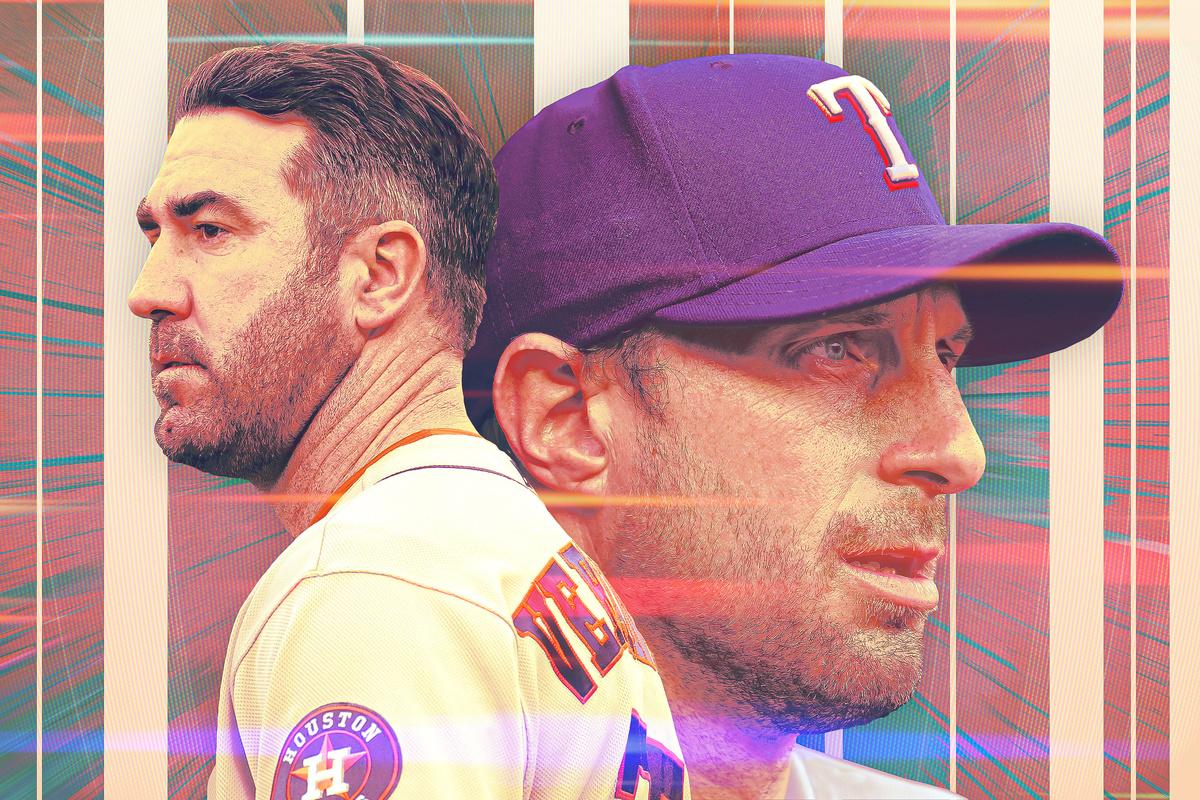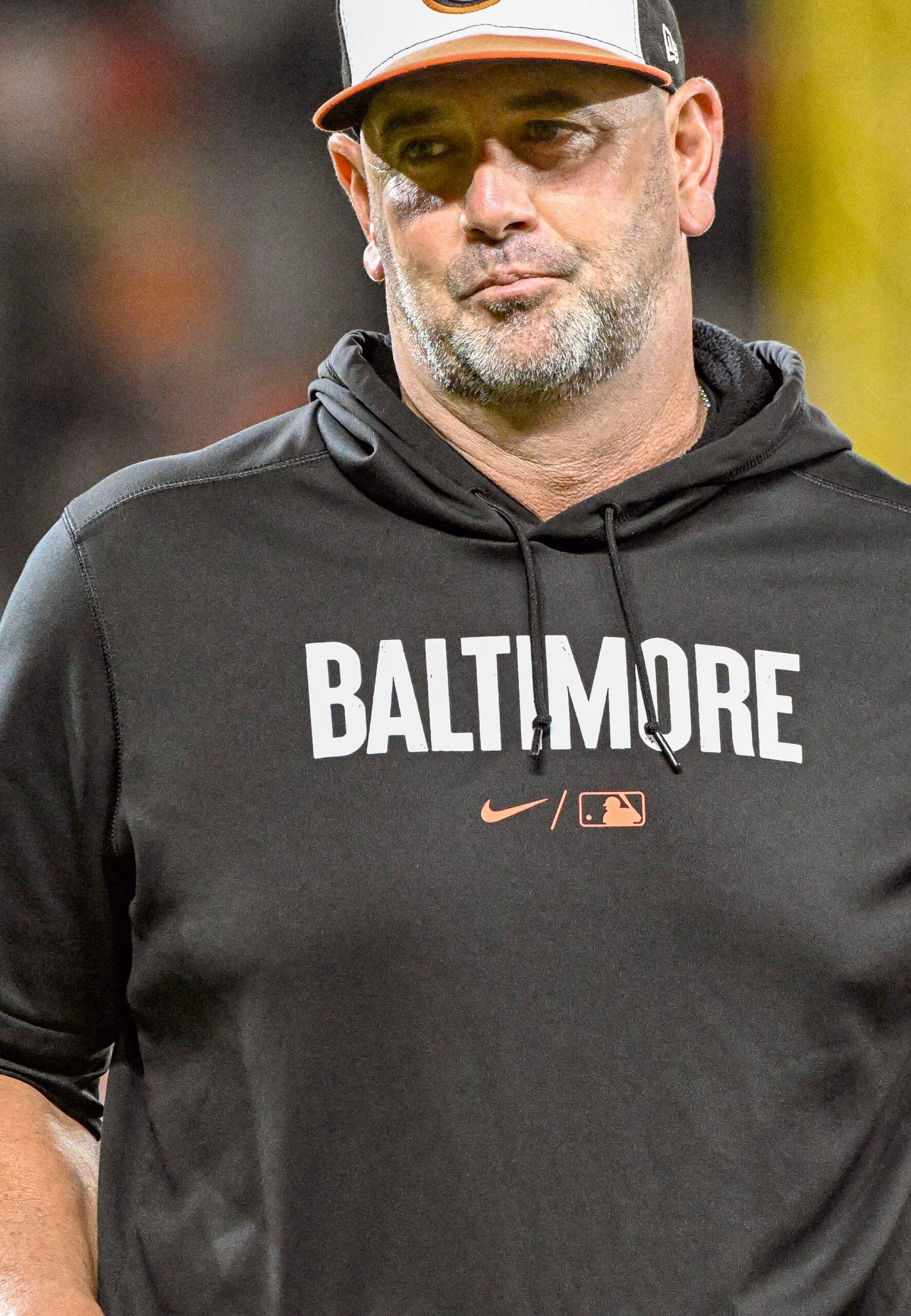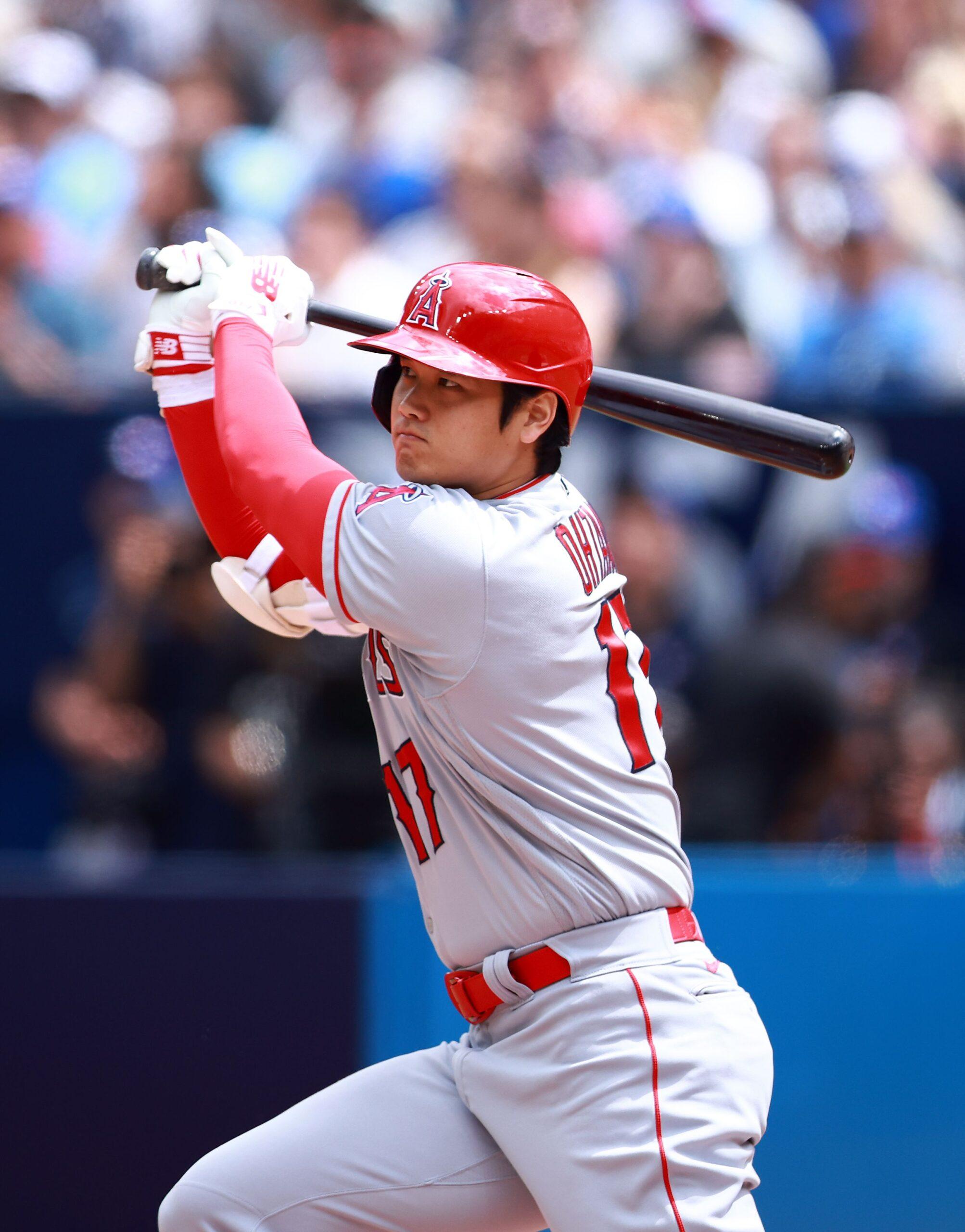
Thanks to the Los Angeles Angels’ decision to keep Shohei Ohtani and push for the playoffs rather than trade the impending free agent, the 2023 MLB trade deadline lacked the blockbusters of 2022, when Juan Soto was dealt, or 2021, when Max Scherzer and Trea Turner went west in the same massive trade. But all 30 teams (even the Colorado Rockies) were active near the deadline, so it’s time to pick the initial winners and losers from the latest midseason frenzy.
Winner: Texas Rangers
In: Max Scherzer, Jordan Montgomery, Aroldis Chapman, Chris Stratton, Austin Hedges
Out: Luisangel Acuña, Tekoah Roby, John King, Thomas Saggese, Cole Ragans, Roni Cabrera
The Rangers are in first place in the AL West because they worked hard to transform a directionless team into a winner. Over the last two winters, Texas committed more than $750 million to Jacob deGrom, Corey Seager, Marcus Semien, Jon Gray, and Nathan Eovaldi.
And voila, a powerful offense led by Seager and Semien, plus 2023 All-Stars Adolis García, Jonah Heim, and Josh Jung, has propelled the Rangers to the best run differential in the American League. The team is firmly on track to reach the playoffs for the first time since 2016.
But the Rangers’ most valuable pitcher this season, Eovaldi, is now on the injured list with a forearm strain. And their second-most-valuable pitcher, per FanGraphs WAR, is out for the season due to Tommy John surgery. (Yes, deGrom is still second among Rangers pitchers in fWAR this season despite making only six starts. He’s ridiculous.)
In those injured leaders’ absence, Texas’s other starters didn’t make for a particularly fearsome foursome. Martín Pérez and Andrew Heaney haven’t recaptured their 2022 magic, while Gray and Dane Dunning have solid surface stats but much more worrisome peripherals. That group wouldn’t inspire much confidence in the playoffs—to say nothing of the next two months, as Texas tries to hold off the half-game-back Astros for the AL West title.
So the Rangers, already pushing hard to contend, pushed a little harder at the deadline. They’d already acquired Aroldis Chapman—by the numbers, the best available reliever—to bolster the bullpen in late June. Then they went to work on the rotation. Texas should feel very comfortable starting Scherzer and Montgomery four times in a seven-game series.
The team dealt from a position of strength: While Acuña is an excellent infield prospect, the Rangers have Seager, Semien, and Jung under contract for the next half decade at least. And although Scherzer, who just celebrated his 39th birthday, no longer looks like Prime Scherzer anymore—largely because of a home run spike this season—he’s still a formidable playoff pitcher with ample experience. He’s also signed for 2024 (unlike Montgomery, a free agent after this season), and because the Mets are spending down some of Scherzer’s remaining salary, the Rangers are essentially paying him Jameson Taillon or Taijuan Walker money. They’ll gladly take that bargain, this season and next.
Winner: The Prospect of a Max Scherzer Vs. Justin Verlander Duel to Decide the AL West
This one’s self-explanatory: The Astros are trying to chase down the Rangers for their sixth division title in seven years, so they responded to Texas’s acquisition of a future Hall of Famer from the Mets with an equivalent move.
Like Scherzer, Verlander isn’t quite his old self anymore. The 40-year-old hurler has been better lately (1.49 ERA in his last seven starts), but his strikeout rate has dropped from 28 percent last season to 21 percent this season—the second-largest decrease among pitchers with at least 90 innings. The largest drop (a whopping 10 percentage points) belongs to Cristian Javier, which helps explain why the Astros wanted Verlander back, after they didn’t re-sign him last winter: Beyond Framber Valdez, Houston’s injury-ravaged rotation is weaker than expected.
The Astros know firsthand just how much Verlander can help them reach a new level in the playoffs. Rival teams have seen this film before, and they didn’t like the ending.
Speaking of which …
Winner: Player-Team Reunions
One theme of the 2023 deadline, from stars to afterthoughts, was reunions, as players like Verlander returned to the teams they once called home. Verlander and Kendall Graveman to the Astros. C.J. Cron and Randal Grichuk to the Angels. Kiké Hernández and Joe Kelly to the Dodgers. Trayce Thompson to the White Sox. Jeimer Candelario to the Cubs.
One wonders whether any of their old/new teams kept any jerseys in the back of a closet somewhere, to recycle and return to use.

Loser: Baltimore Orioles
In: Jack Flaherty, Shintaro Fujinami, Logan Rinehart
Out: César Prieto, Drew Rom, Zack Showalter, Easton Lucas, Eduard Bazardo
The Orioles are like the Rangers—a surprising first-place team at the deadline. But they’re also not like the Rangers, because it’s unclear whether the Orioles actually realized they’re a first-place team at the deadline. Texas acted like it, strengthening its roster in an effort to both make the playoffs and maximize its opportunity once there.
Baltimore, though, acted with nowhere near that amount of aggression, even though the Orioles had more prospect depth to trade than any other contender. The Orioles have so many good young hitters that they can’t even play all of them together—yet they didn’t use any of their top 25 prospects, by FanGraphs’ reckoning, to upgrade at the deadline. There’s a large gap between not “set[ting] the minor league system on fire just because we’re in first place,” which GM Mike Elias warned against doing, and holding every notable prospect close.
It’s not as if Baltimore is devoid of holes, either. The bullpen is overly reliant on just two brilliant arms, Félix Bautista and Yennier Cano, and Cano has struggled of late, with a 4.91 ERA and 1.018 OPS allowed in his last 13 appearances. Yet the club’s only bullpen addition was Fujinami, a speculative acquisition with control problems who was terrible for the A’s this season.
The starting rotation is in even more dire straits, ranking 19th in the majors in WAR this season, and without a true ace who can helm a playoff rotation. How does some combination of Kyle Gibson, Kyle Bradish, Grayson Rodriguez, Dean Kremer, and Tyler Wells (recently demoted to Double-A after a slump) sound in October? The club has succeeded with such uninspired rotations before—remember when Joe Saunders beat Yu Darvish in a wild-card game, or when Chris Tillman, Wei-Yin Chen, and Bud Norris swept Verlander, Scherzer, and David Price?—but that doesn’t mean Baltimore’s bound to win in the same fashion again a decade later.
And all the team did in this regard was add Flaherty in the final minutes before the deadline. Flaherty’s a big name—but now he’s only an average pitcher, not the top-of-the-rotation type the Orioles need. While Flaherty was dominant for the Cardinals en route to the NLCS in 2019, he hasn’t posted an above-average FIP in any full-length season since then. His strikeouts have fallen, his walks have risen, and now he’s an impending free agent who’s largely indistinguishable from the Gibsons of the world.
Make no mistake, the Orioles are still flying high with the best record in the American League, and their fans should still be exuberant about the team’s overall direction. But their playoff potential would look a lot less precarious if they’d cashed in some of their prospect value to make a real run at the 2023 title.
Winner: New York Mets
In: Luisangel Acuña, Drew Gilbert, Ryan Clifford, Marco Vargas, Ronald Hernandez, Jeremy Rodriguez, Coleman Crow, Landon Marceaux, Jeremiah Jackson, Phil Bickford, Adam Kolarek
Out: Max Scherzer, Justin Verlander, David Robertson, Mark Canha, Tommy Pham, Eduardo Escobar, Dominic Leone
From a preseason vantage point, of course, the Mets aren’t winners for selling at the deadline. But with the context that they no longer have championship aspirations in 2023, now that they’re below .500 and six games out of a playoff spot, they had the best deadline of any seller in the league.
Of course, it helps to have desirable players, which the Mets, thanks to the majors’ highest payroll, had while the league’s cellar dwellers didn’t. But they also deserve credit for properly assessing their place in the standings and capitalizing on a seller’s market, and for flexing their financial might when possible.
Other teams in their situation might have decided to off-load high salaries. Instead, owner Steve Cohen agreed to send money in trades—for Scherzer, more than $30 million; for Verlander, at least that much; for Canha, his entire salary minus the league minimum; plus all the luxury tax extras all those payments entail—to boost the Mets’ prospect return. Would Scherzer at his full salary have fetched Acuña? No. But Scherzer at Taillon or Walker money did.
And that prospect return is considerable. Acuña—Ronald’s younger brother—and Vargas are two promising up-the-middle infield prospects, and outfielders Gilbert and Clifford are the Astros’ top two minor leaguers, according to MLB Pipeline’s Jim Callis. In other words, the Mets turned a trio of old pitchers into four top-100 prospects. That timeline shift might hurt them in 2024, but it sets the organization up much better for the long-term success Cohen seeks.
Loser: New York Yankees
In: Keynan Middleton, Spencer Howard
Out: Juan Carela
The other New York team was a lot less active, and a lot less successful, at the deadline. I won’t belabor this point because I devoted more than 2,000 words to the Yankees’ problems last week. Suffice it to say, one replacement-level reliever—Middleton is at 0.0 WAR over 180 career MLB innings—and one pitcher with a career 7.20 ERA will not make the difference in the Yankees’ push for a seventh straight playoff berth.
Losers: Teams in Need of Offense
While notable pitchers changed teams on a seemingly constant basis during the days leading into the deadline, their position player equivalents were almost nowhere to be found. The best position player to change teams at the deadline was new Cubs third baseman Jeimer Candelario, who rebounded from being non-tendered over the winter to tally 3.1 fWAR for the Nationals. He’s tied for 30th among position players in WAR this season.
But the next-best position player traded was Tommy Pham, all the way down in a tie for 95th on the WAR leaderboard. There are plenty of reasons that so few impact bats were available: Fringe contenders like the Cubs and Angels decided to become buyers rather than trade Cody Bellinger or Ohtani; the underachieving Mets had more pitchers than hitters to trade, while the underachieving Cardinals kept their big bats in place to contend in 2024; the upcoming free-agent class of hitters is similarly underwhelming, so desirable rentals weren’t on the market.
The result, in any case, is that most of the teams seeking to fill a hole in the lineup went unfulfilled. Now the likes of the Yankees, Twins, and Phillies will all have to hope for internal improvements over the next two months.

Winner: The YOLO Angels
In: Lucas Giolito, Reynaldo López, C.J. Cron, Randal Grichuk, Mike Moustakas, Eduardo Escobar
Out: Edgar Quero, Ky Bush, Jake Madden, Mason Albright, Connor Van Scoyoc, Coleman Crow, Landon Marceaux, Tucker Davidson
It’s rare that an MLB team ever displays the sort of urgency the Angels have over the past week. Perhaps the last such team was the Cubs in 2016, who wildly overpaid for Chapman as a rental closer (surrendering top prospect Gleyber Torres) because they knew they had a chance at their first championship in 108 years.
The 2023 Angels aren’t anywhere near as good as the 103-win 2016 Cubs, but their ambitions are also much more modest: They just want to qualify for the playoffs before Ohtani reaches free agency this winter. At 56-51, needing to leapfrog multiple teams to reach a playoff spot while also fending off the Mariners and Yankees right behind them, the Angels face long odds to do so: only 17 percent, per FanGraphs.
But darn it, they’re trying, at least.
Instead of trading Ohtani for a potentially record-setting haul for a rental, the Angels pivoted to buy instead, across all areas of the roster. Giolito will help the rotation, López the bullpen—he recorded a five-out save in his second appearance with the team—and Cron and Grichuk the lineup, which was in particular need of a boost after outfielder Taylor Ward took a pitch to the face, likely ending his season.
The cost for a bunch of rentals was steep, but necessary if the club wants to make an honest effort in Ohtani’s possible last hurrah. Now the club is all in for a 1-in-6 playoff chance, having scraped the cupboard bare for these final upgrades. Out of the top 13 Angels prospects entering this season, per FanGraphs, five have already appeared in the majors, including two 2022 draftees (shortstop Zach Neto and reliever Ben Joyce), while another four were traded at the deadline.
The odds say this series of moves won’t pay off with a playoff berth. But the Angels are essentially screwed if Ohtani leaves after this season, anyway. Why not at least try while the best player in the world is enjoying his best season?
Loser: ERA
Sabermetric-minded analysts have long since moved past earned run average as a key evaluative statistic—but it was still striking to see how little contending teams cared about their trade targets’ ERAs at this deadline. Here is a list of some of the pitchers traded, along with their ERAs at the time of the deals. (For context, the overall MLB ERA this season is 4.31.)
- Shintaro Fujinami (A’s to Orioles): 8.57
- Noah Syndergaard (Dodgers to Guardians): 7.16
- Lance Lynn (White Sox to Dodgers): 6.47
- Scott Barlow (Royals to Padres): 5.35
- Jorge López (Twins to Marlins): 5.09
- Joe Kelly (White Sox to Dodgers): 4.97
- Rich Hill (Pirates to Padres): 4.76
- José Cuas (Royals to Cubs): 4.54
- Dylan Floro (Marlins to Twins): 4.54
- Brad Hand (Rockies to Braves): 4.54
- Sam Moll (A’s to Reds): 4.54
- Jack Flaherty (Cardinals to Orioles): 4.43
- Chris Stratton (Cardinals to Rangers): 4.36
- Reynaldo López (White Sox to Angels): 4.29
- Max Scherzer (Mets to Rangers): 4.01
ERA, as a single number, doesn’t tell the whole story about these pitchers. Fujinami, for instance, has been much better in the bullpen since a disastrous stint in the rotation, which is why the league-leading Orioles wanted a reliever who’d allowed nearly a run per inning for the league-trailing A’s; many have much better peripherals—like strikeout rate and FIP—than their ERAs suggest; some, like Moll, are platoon-dependent arms who can be deployed strategically against same-handed hitters.
Moreover, in an era of pitch design and repertoire optimization, savvy teams believe they know how to unlock the best, trickiest traits of the pitchers they target and acquire. That doesn’t mean they’ll all succeed, but it’s a sign of the times that so many think they can.
Loser: Kansas City Royals
In: Taylor Hearn, Tucker Davidson, Cole Ragans, Roni Cabrera, Nelson Velázquez, Henry Williams, Jesus Rios, Devin Mann, Derlin Figueroa
Out: Aroldis Chapman, Nicky Lopez, José Cuas, Scott Barlow, Ryan Yarbrough
Finally, we’ll end this deadline wrap-up with a team near the bottom of the standings. The Royals are deadline losers for three reasons. The first is their misguided mentality. The team is 32-75, on pace for the worst season in franchise history, with one of the worst farm systems in the majors—yet instead of focusing on a longer-term, larger-scale refresh, management approached the deadline from the perspective that the club is closer to competing now.
“We’d like to acquire someone that would add to our major league team or (be) near-ready for our major league team,” general manager J.J. Picollo said last week. “When you have guys on major league teams and you’re trading them for three or four minor league prospects and years of control, that’s really not the direction we want to go in.”
Odd. So too was the decision to trade rental reliever Chapman on June 30, for what looks in retrospect like a relatively light return. Kansas City received two non-impact youngsters in the deal, but closer to the deadline, the Mets, Cardinals, and White Sox received better prospects for David Robertson, Jordan Hicks, and Kendall Graveman, respectively—even though Chapman had the best numbers of any reliever traded this summer.
The coup de grâce, though, was the weirdest deadline decision for any team, as the Royals traded Lopez for Hearn. Lopez isn’t a star, or even a starter on a contending team: He’s best suited as a reserve utility man, which is exactly how he’ll be used in Atlanta.
But Lopez is still a valuable player, largely because he rates as an excellent defender across the infield spectrum. In 2021, Lopez was only an average hitter but was worth a shocking 6.0 WAR because of his defensive strength; even with a woeful 61 wRC+ since then, he’s still rated well above replacement level overall.
And the Royals received only Hearn—a major leaguer, as Picollo desired—in return. Hearn is slightly older than Lopez, has just as much service time, is less valuable at a less valuable position, and, oh yeah, was designated for assignment by the Rangers just a week earlier. The Royals could have acquired Hearn just with cash, as Atlanta did! Instead, they waited a week and traded an actually useful player for him. Other deadline trades from other teams produced much bigger headlines—but none yielded more confusion.

